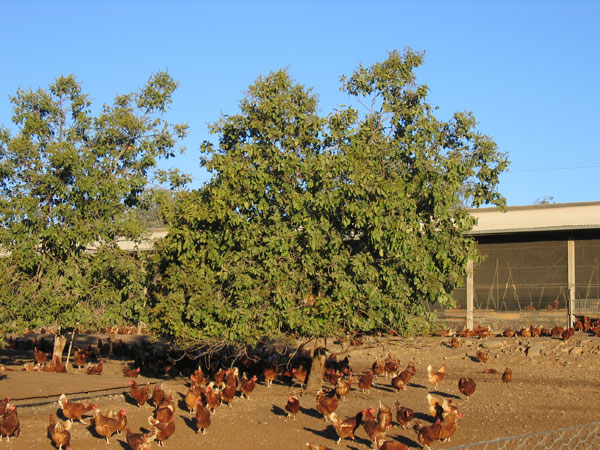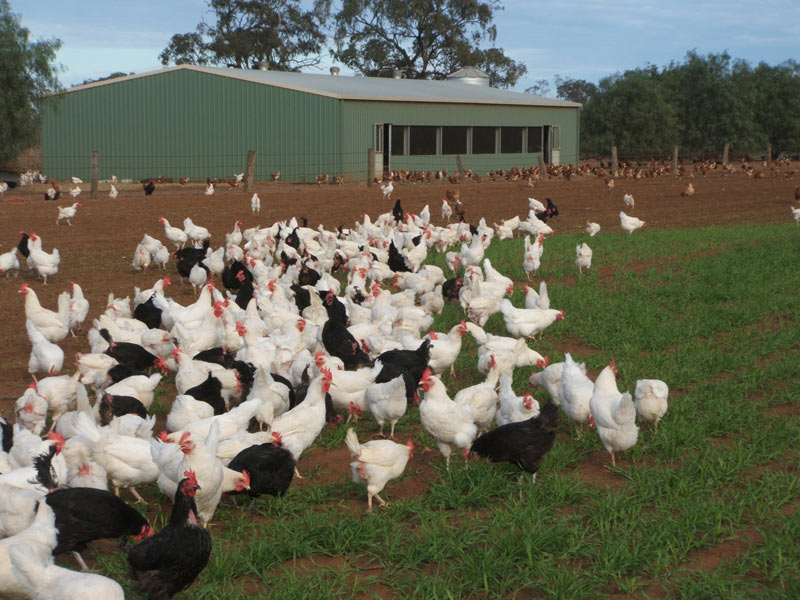Alternative poultry production systems
Alternative poultry production systems

Free range production system
Free-range
Free-range is the poultry housing system most actively supported by welfare groups for egg production. Free Range poultry system for commercial production of eggs or chicken meat is considered an environmentally sustainable land use practice. This is achieved by limiting the stocking densities of birds outside the shed. The stocking density for free-range laying hens is set at no more than 10,000 birds per hectare of outdoor range.
Under the Model Code of Practice for the Welfare of Animals (domestic fowl), free-range allows poultry the maximum access to its natural behavioural instincts. Free-range hens are free to roam during daylight hours but are secured at night to protect them from inclement weather and predators. Feed and potable water points are available within the shed housing which is in accordance with biosecurity regulations. Beak trimming is acceptable when carried out by accredited personnel only when all other treatments have been exhausted and must be initiated under veterinary instructions. In the free-range system beak trimming at day old is not adopted. Human contact within the free-range system is vital as constant interaction is necessary during hand egg collection, cleaning and monitoring stock.
Limited stocking density per shed is required to allow the hens’ freedom of movement based on the Farm Animal Welfare Code ‘five freedoms’. These are:
- Freedom from hunger and thirst
- Freedom from discomfort
- Freedom from pain, injury and disease
- Freedom to express normal behaviour
- Freedom from fear and distress
Free-range chicken meat accounts for approximately 10 to 15% of chicken produced, with less than 1% of the total production also being organic. Free-range meat chickens are produced using similar management, housing and feeding practices as conventional meat chickens. The major differences are that free-range chickens are allowed access to an outside run for part of each day (at least post the brooding period), have lower target stocking densities and some health issues are managed differently. Antibiotics can be used to treat sick birds but, once treated, the meat from these birds cannot be sold as free-range. The main certifier of free-range chicken meat in Australia is Free Range Egg and Poultry Australia Ltd (FREPA). The standards that free-range meat chickens must comply with to be certified by FREPA. The major suppliers of free-range chickens are two of the three largest companies operating in the commercial chicken meat industry.
Barn
The Barn poultry layer system is a mix between the cage system and free-range system. Barn hens are housed on deep litter in secure and weatherproof sheds. While they are provided with ample water, feed, ventilation, space and nesting boxes in accordance with the Model Code of Practice for the Welfare of Animals (domestic farm), they do not range out of doors. Limited stocking density allows room for the opportunity to express their full range of natural behaviours. They have the freedom to flap their wings, stretch, fly and dust bathe. This allows hens to move around and explore their environment. The extra space also allows submissive birds to avoid dominant birds if they need to, which can reduce aggressive pecking and improve welfare. Hens have access to a private, enclosed area for laying, which is a priority for hens. Beak trimming is generally allowed with the beak of most birds trimmed at day old to limit feather pecking and cannibalism. Barn sheds are usually fully automated with central nesting boxes over conveyor belts which carry the eggs out of the shed into a packing area, thus avoiding human contact.

Free range chickens
Certified organic
Only free-range hens can be used to produce certified organic eggs and meat and must be grown without the use of artificial colours and synthetic chemicals, according to the national standards. Birds are fed certified organic feed grown from soil that is certified as organic and does not contain pesticides or inorganic fertilisers. Under the regulations, no antibiotic medication is to be used for treatment of organic poultry. Organic standards for egg production specify the types of feed, accommodation, and living conditions which are suitable for organic laying hens. While healthy hens require shelter for security and protection against the elements, they also benefit from the freedom to scratch and forage naturally outdoors. A clean, pollution-free range provides a suitably varied natural diet, one that is rich in essential vitamins, minerals, and trace elements.
Certified organic meat chickens have two additional requirements as well as having to be free-range:
- Feed must be predominantly from certified organic ingredients.
- Birds cannot be treated with routine vaccination. There are exceptions, such as where treatment is required by law or disease cannot be controlled with organic management practices.
Certified organic chicken meat bears a certification logo from an approved organisation, and producers must comply with The National Standard for Organic and Bio-Dynamic Produce.

